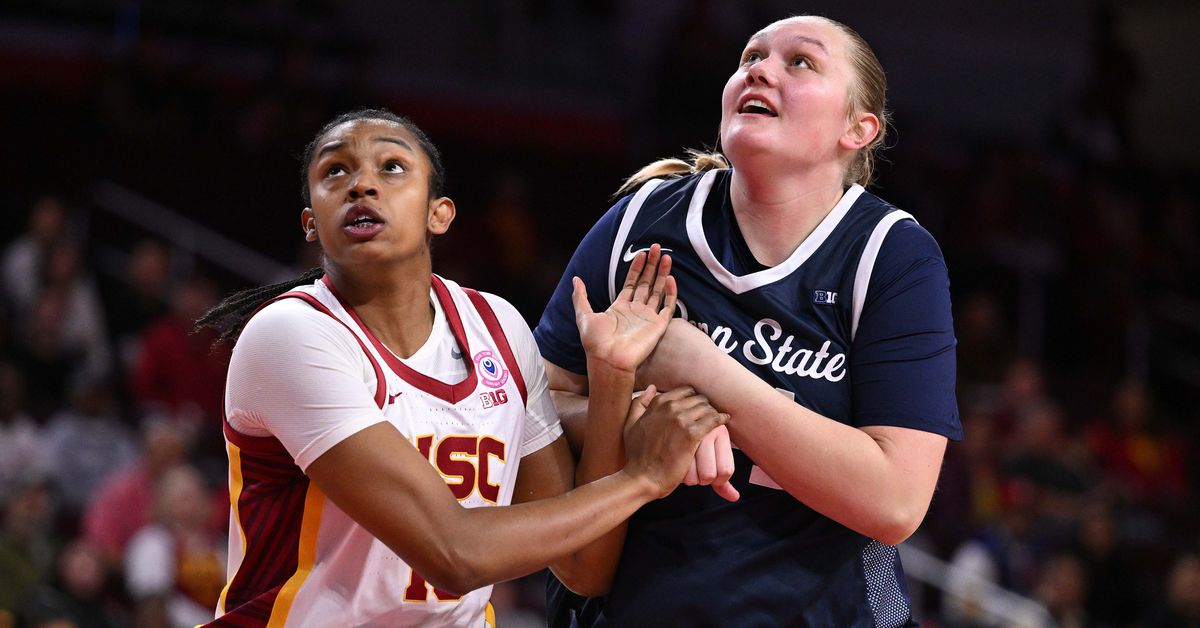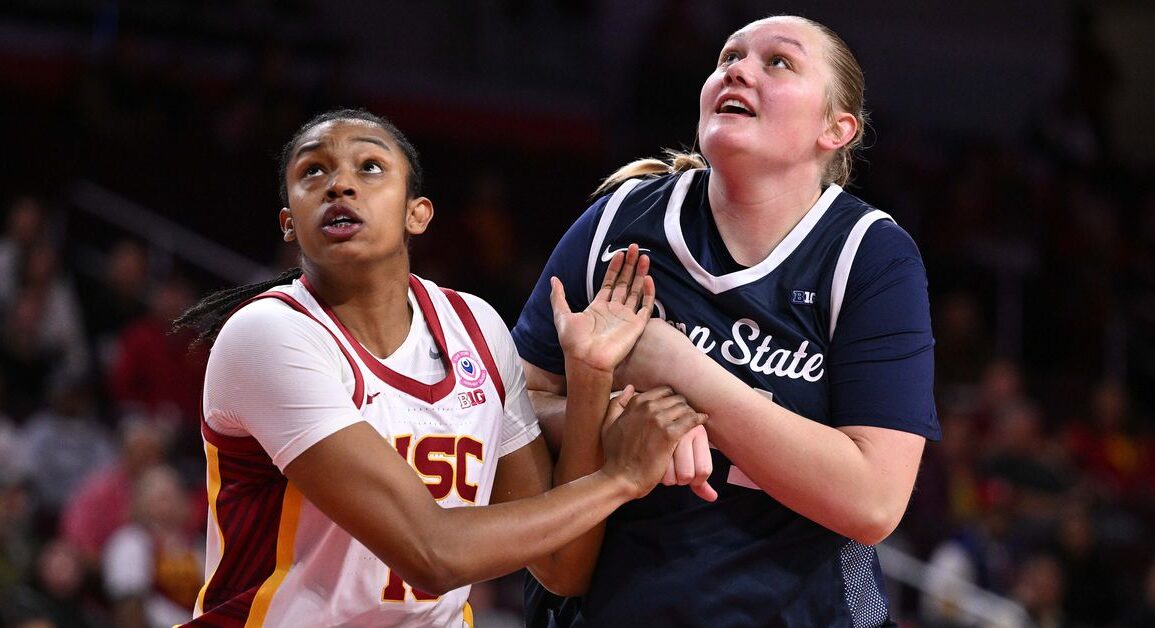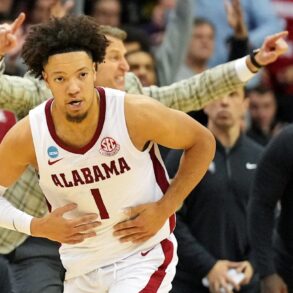
In the span of 56 days, Gracie Merkle transferred from Penn State to Maryland and back to Penn State.
Yes, really.
Well, sort of.
Merkle, a 6-foot-6 redshirt junior center, entered the transfer portal on March 25 with a do-not-contact tag. Despite playing for the worst team in the Big Ten — the Nittany Lions went 1-17 in conference play last season — Merkle was a highly sought-after transfer after averaging 15.5 points and 8.6 rebounds per game. She was fourth-nationally in field goal percentage, making 67 percent of her shots with her soft touch around the rim.
On April 5, she announced on her Instagram that she was committing to Maryland, complete with a graphic featuring her in a Terrapins’ jersey with the caption “GO TERPS.” Merkle became a key building block of one of the strongest transfer portal classes assembled this offseason, as Terps coach Brenda Frese also landed commitments from ACC Tournament MVP Oluchi Okananwa from Duke and Indiana’s Yarden Garzon, an All-Big Ten selection and 3-and-D specialist.
Merkle even recorded a video for the Terps’ social channels, saying how “excited” she was to join the team. She added in a statement issued by Maryland on April 8 that said: “I chose Maryland because of the winning culture. I developed a belief in the coaching staff and a relationship with the players as soon as I stepped on campus. The development I’m looking for is proven with Coach Frese.”
As it turns out, the statement, the news release, the video, the graphic, the photo shoot, the social media posts — it was all a waste of time.
Because Merkle is not going to play basketball at the University of Maryland.
She backpedaled on Monday night and announced that, indeed, she’s staying at Penn State.
“Plot twist! After much thought, prayer and communication with my family, I have been released from UMD per my request,” Merkle wrote on Instagram. “I am very thankful for the opportunity but I have decided to return to Penn State University!!!! As always, I appreciate all the love and support.”
So, how did this happen? How did a player transfer to a new school and then back out of it a month later?
SB Nation spoke to a few coaches, agents and other sources around women’s college basketball to better understand the system and the circumstances.
So, who is Gracie Merkle?
She’s a pretty good collegiate center from Mount Washington, Kentucky. She began her college career at the mid-major level at Bellarmine where she averaged 14.6 points and 10.6 rebounds as a true freshman and ranked second nationally in shooting percentage with a 70.1 percent mark. She was also 16th nationally in rebounds per game and won the ASUN Rookie of the Year award.
After sitting out her sophomore season due to an injury, Merkle transferred to Penn State where she continued to put up similar numbers against stiff competition in the Big Ten. While the Nittany Lions struggled, going 10-19, Merkle had a solid season and was an All-Big Ten honorable mention selection.
There weren’t many true post players in the portal this year, so Merkle was coveted as someone who could score in the paint, rebound and protect the rim at a high level.
In early April she signed with Maryland.
What did Merkle sign?
Merkle signed something commonly referred to as a financial agreement, a source confirmed, which is what all transfers are asked to sign when they go to a new school.
The thing is, these financial agreements are a bit different from what high school recruits used to sign when they committed to colleges — a National Letter of Intent. NLIs don’t exist anymore though after the NCAA eliminated them in October, ending the program that began in 1964.
An NLI was a formal and binding agreement between a player and the program they were choosing to attend. They were hard to get out of.
The new financial agreements are anything but that. The loopholes are easy to exploit.
One Power 4 assistant coach put it this way: “You can get out of a financial agreement anytime now as long as you haven’t stepped on campus and started getting aid… These are basically verbal commitments.”
The NLI was eliminated as the NCAA anticipates more changes from the House settlement, which will pave the way for schools to share revenue directly with players.
One agent referred to the financial agreements as “just MOUs” or memorandums of understanding, another form of a non-binding agreement.
“Financial aid agreement basically means nothing until you physically attend a class,” another Power 4 assistant coach said.
A source familiar with Merkle’s situation confirmed to SB Nation that, aside from her visit during her recruitment, she never stepped on campus and never enrolled in classes in College Park.
Once a player signs a financial agreement with a school, other programs are supposed to be prohibited from communicating with them about recruiting, according to NCAA guidelines.
But isn’t the transfer portal closed? How did Merkle go back to Penn State?
Indeed, the transfer portal is closed. But Merkle never had to reenter the portal because she never exited it. She didn’t start working out with Maryland, she didn’t attend classes there and didn’t receive financial aid.
And once a player enters the transfer portal, they’re technically in it for the season. When a player signs a financial agreement with a new school, the portal will show that, but the player will still exist in the portal.
One veteran coach summed it up this way: “Since she went in for the 2024-25 season, even if she signed and it signified as much in the portal, she’s still in there… If I open up the portal right now and look up (MiLaysia) Fulwiley, I’ll see that she’s signed to LSU, but she’s still listed. So, does that still count as being in there?”
This actually already happened in women’s college basketball during this portal cycle. Auburn’s Kaitlyn Duhon, a solid defender who has averaged 4.9 points per game for her career, signed with Texas A&M on April 1. Weeks later, she announced she was going back to Auburn.
Last year, football player Kadyn Proctor transferred from Alabama to Iowa, but less than two months later returned to Alabama before ever participating in a practice with the Hawkeyes.
“It’s so weird how it all works,” another coach told SB Nation.
What does this mean for Maryland and Penn State?
Merkle likely would’ve been the Terps’ starting center next season, especially following the departure of Allie Kubek — a 6-foot-2 forward who entered the portal and transferred to Florida State after the arrivals of Merkle, Garzon and Okananwa were announced.
The Terps still have a solid roster capable of making a deep March Madness run, but Garzon is now their tallest listed player at 6-foot-3, and she’s at her best when she can play along the wings instead of spending the majority of her time down in the paint. Brenda Frese has played small-ball lineups over the past few years, but having a true formidable post like Merkle would’ve been a luxury.
In addition to Merkle’s return, Penn State added dynamic Rutgers guard Kiyomi McMiller through the portal. A former Jordan Brand All-American, she averaged 18.7 points as a true freshman for the Scarlet Knights. Because of various benchings, suspensions and other circumstances, McMiller only played in 21 of 33 games for Rutgers this season.
The Big Ten has yet to set its women’s basketball schedule for the 2025-26 season, but the meeting between Maryland and Penn State will be one to circle on the calendar.
This post was originally published on this site be sure to check out more of their content.





